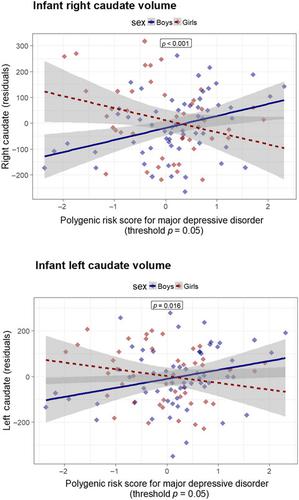当前位置:
X-MOL 学术
›
J. Neurosci. Res.
›
论文详情
Our official English website, www.x-mol.net, welcomes your
feedback! (Note: you will need to create a separate account there.)
Sex-specific association between infant caudate volumes and a polygenic risk score for major depressive disorder.
Journal of Neuroscience Research ( IF 2.9 ) Pub Date : 2020-09-09 , DOI: 10.1002/jnr.24722 Henriette Acosta 1, 2 , Katri Kantojärvi 3, 4 , Jetro J Tuulari 1, 5, 6, 7 , John D Lewis 8 , Niloofar Hashempour 1 , Noora M Scheinin 1, 5 , Satu J Lehtola 1 , Vladimir S Fonov 8 , D Louis Collins 8 , Alan Evans 8 , Riitta Parkkola 9 , Tuire Lähdesmäki 10 , Jani Saunavaara 11 , Harri Merisaari 1, 12, 13 , Linnea Karlsson 1, 14 , Tiina Paunio 3, 4 , Hasse Karlsson 1, 5, 14
Journal of Neuroscience Research ( IF 2.9 ) Pub Date : 2020-09-09 , DOI: 10.1002/jnr.24722 Henriette Acosta 1, 2 , Katri Kantojärvi 3, 4 , Jetro J Tuulari 1, 5, 6, 7 , John D Lewis 8 , Niloofar Hashempour 1 , Noora M Scheinin 1, 5 , Satu J Lehtola 1 , Vladimir S Fonov 8 , D Louis Collins 8 , Alan Evans 8 , Riitta Parkkola 9 , Tuire Lähdesmäki 10 , Jani Saunavaara 11 , Harri Merisaari 1, 12, 13 , Linnea Karlsson 1, 14 , Tiina Paunio 3, 4 , Hasse Karlsson 1, 5, 14
Affiliation

|
Polygenic risk scores for major depressive disorder (PRS‐MDD) have been identified in large genome‐wide association studies, and recent findings suggest that PRS‐MDD might interact with environmental risk factors to shape human limbic brain development as early as in the prenatal period. Striatal structures are crucially involved in depression; however, the association of PRS‐MDD with infant striatal volumes is yet unknown. In this study, 105 Finnish mother–infant dyads (44 female, 11–54 days old) were investigated to reveal how infant PRS‐MDD is associated with infant dorsal striatal volumes (caudate, putamen) and whether PRS‐MDD interacts with prenatal maternal depressive symptoms (Edinburgh Postnatal Depression Scale, gestational weeks 14, 24, 34) on infant striatal volumes. A robust sex‐specific main effect of PRS‐MDD on bilateral infant caudate volumes was observed. PRS‐MDD were more positively associated with caudate volumes in boys compared to girls. No significant interaction effects of genotype PRS‐MDD with the environmental risk factor “prenatal maternal depressive symptoms” (genotype‐by‐environment interaction) nor significant interaction effects of genotype with prenatal maternal depressive symptoms and sex (genotype‐by‐environment‐by‐sex interaction) were found for infant dorsal striatal volumes. Our study showed that a higher PRS‐MDD irrespective of prenatal exposure to maternal depressive symptoms is associated with smaller bilateral caudate volumes, an indicator of greater susceptibility to major depressive disorder, in female compared to male infants. This sex‐specific polygenic effect might lay the ground for the higher prevalence of depression in women compared to men.
中文翻译:

婴儿尾状核体积与重度抑郁症的多基因风险评分之间的性别特异性关联。
在大型全基因组关联研究中已经确定了重度抑郁症 (PRS-MDD) 的多基因风险评分,最近的研究结果表明,PRS-MDD 可能与环境风险因素相互作用,早在产前阶段就影响人类边缘大脑的发育. 纹状体结构与抑郁症有关。然而,PRS-MDD 与婴儿纹状体体积的关联尚不清楚。在这项研究中,对 105 名芬兰母婴双胞胎(44 名女性,11-54 天大)进行了调查,以揭示婴儿 PRS-MDD 如何与婴儿背侧纹状体体积(尾状核、壳核)以及 PRS-MDD 是否与产前母体相互作用婴儿纹状体体积的抑郁症状(爱丁堡产后抑郁量表,妊娠第 14、24、34 周)。观察到 PRS-MDD 对双侧婴儿尾状核体积的强大的性别特异性主要影响。与女孩相比,PRS-MDD 与男孩的尾状核体积呈正相关。基因型 PRS-MDD 与环境危险因素“产前母亲抑郁症状”(基因型-环境相互作用)没有显着的交互作用,基因型与产前母亲抑郁症状和性别(基因型-环境-由-性相互作用)被发现用于婴儿背侧纹状体体积。我们的研究表明,与男性婴儿相比,女性婴儿的双侧尾状核体积较小,而无论产前是否暴露于母体抑郁症状,较高的 PRS-MDD 都与此相关,这表明女性对重度抑郁症的易感性更高。
更新日期:2020-10-19
中文翻译:

婴儿尾状核体积与重度抑郁症的多基因风险评分之间的性别特异性关联。
在大型全基因组关联研究中已经确定了重度抑郁症 (PRS-MDD) 的多基因风险评分,最近的研究结果表明,PRS-MDD 可能与环境风险因素相互作用,早在产前阶段就影响人类边缘大脑的发育. 纹状体结构与抑郁症有关。然而,PRS-MDD 与婴儿纹状体体积的关联尚不清楚。在这项研究中,对 105 名芬兰母婴双胞胎(44 名女性,11-54 天大)进行了调查,以揭示婴儿 PRS-MDD 如何与婴儿背侧纹状体体积(尾状核、壳核)以及 PRS-MDD 是否与产前母体相互作用婴儿纹状体体积的抑郁症状(爱丁堡产后抑郁量表,妊娠第 14、24、34 周)。观察到 PRS-MDD 对双侧婴儿尾状核体积的强大的性别特异性主要影响。与女孩相比,PRS-MDD 与男孩的尾状核体积呈正相关。基因型 PRS-MDD 与环境危险因素“产前母亲抑郁症状”(基因型-环境相互作用)没有显着的交互作用,基因型与产前母亲抑郁症状和性别(基因型-环境-由-性相互作用)被发现用于婴儿背侧纹状体体积。我们的研究表明,与男性婴儿相比,女性婴儿的双侧尾状核体积较小,而无论产前是否暴露于母体抑郁症状,较高的 PRS-MDD 都与此相关,这表明女性对重度抑郁症的易感性更高。







































 京公网安备 11010802027423号
京公网安备 11010802027423号